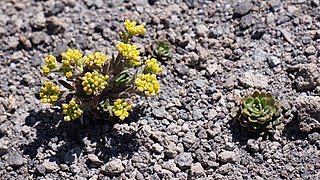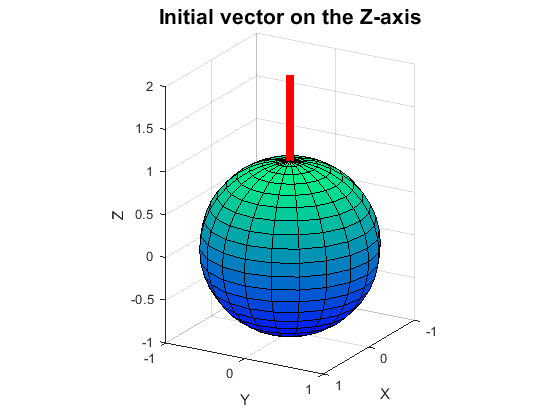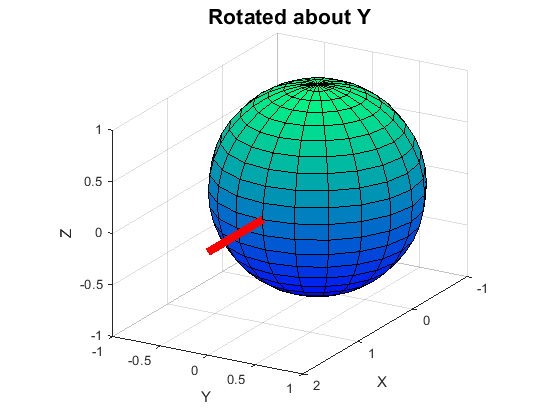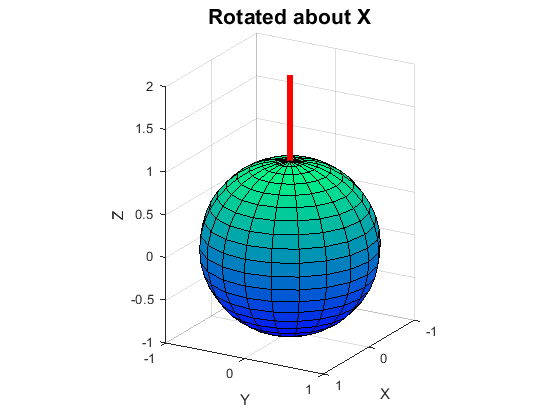12.2: Matrix Multiplication Applications
- Page ID
- 88004
By Carey Smith
Rotation Matrices
One use of matrices is to rotate vectors.
A 2D Rotation matrix is of this form:
Mrot2D = [ cosd() -sind() ]
[ sind() cosd() ]
(Use cosd() and sind() when the angle is in degrees.)
Use cos() and sin() when the angle is in radians.)
2D Rotate by 60 degrees clockwise:
Mrot2D60 = [ cosd(60) -sind(60) ] = [ 0.5 -0.866 ]
[ sind(60) cosd(60) ] [ 0.866 0.5 ]
Example code is in the attached file Ex_Rotation2D.m
Solution
Add example text here.
3D Rotation matrices
A 3D Rotation matrix about the z-axis is has a 2D rotation sub matrix in it. It is of this form::
Mrot3Dz = [ cosd(z) -sind(z) 0 ]
[ sind(z) cosd(z) 0 ]
[ 0 0 1 ]
3D Rotation matrix about the X-axis is:
Mrot3Dx = [ 1 0 0 ]
[ 0 cosd(x) -sind(x) ]
[ 0 sind(x) cosd(x) ]
3D Rotation matrix about the Y-axis is:
Mrot3Dy = [ cosd(y) 0 sind(y) ]
[ 0 1 0 ]
[ -sind(y) 0 cosd(y) ]
Example code is in the attached file Ex_Rotation3D.m
This produced the following figures:
|
|
|
|
|
|
Initial vector is on the Z-axis |
Rotate by+90 about Y it goes to the X-axis |
Rotate by+90 about Z it goes to the Y-axis |
Rotate by+90 about X it goes to the Z-axis |
Matrix Powers
A matrix can be raised to a power using matrix multiplication.
A = [1 2
3 4]
A^2 = A*A = [1 2]*[1 2] = [ 7 10]
[3 4] [3 4] [15 22]
A^4 = [199 290]
[435 634]
Solution
Add example text here.
Life Cycle Matrix
A Matrix can be used to model the number of plants or animals at various stages from year to year.
This example considers a small flowering plant called Lake Tahoe Draba. Information about this plant and an image is available at: https://calscape.org/Draba-asterophora-(). That image is copyrighted. The image below is a creative commons image of a similar draba species. The numbers used in this example are made up simply to illustrate a possible application of matrix multiplication.

https://commons.wikimedia.org/wiki/F...orullensis.jpg, Tim Park
This file is licensed under the Creative Commons Attribution-Share Alike 4.0 International license.
Consider these stages of a plant:
- Seed
- Seedling (1st year)
- Mature plant
The numbers of plants in each stage will be the elements of a vector, D, for Draba.
Initialize D to have 20 mature plants, with zeros for the other stages:
D1 = [0
0
20]
Let T = the transition matrix from 1 year to the next.
Assume the following average numbers: (These are made up)1 plant produces 8 seeds.
Fraction of seeds that become seedlings = 0.2
Fraction of seedlings that become mature plants = 0.5
Fraction of plants that survive from year to year = 0.7
Create the transition matrix's rows:
seeds = 8*number of mature plants:
-> T_seeds = [0 0 8]
seedlings = 0.2*number of mature seeds
-> T_seedlings = [0.2 0 0]
New mature plants from seedling = 0.5*seedlings
0.7*mature plants survive from the previous year
T_mature = [0 0.5 0.7]
The T matrix is created by combining these 3 vectors:
T = [T_seeds
T_seedlings
T_mature ]
T= [0 0 8
0.2 0 0
0 0.5 0.7 ]
Compute the numbers of each stage in year 2:
D2 = T*D1
Compute the numbers of each stage in year 3:
D3 = T*D2
Compute the numbers of each stage in year 4:
D4 = T*D3
Compare D4 another way using a matrix power:
D4b = (T^3)*D1
Verify that this produces the same result.
Compute the numbers of each stage in year 10:
D10 = (T^9)*D1
Solution
Add example text here.
.






